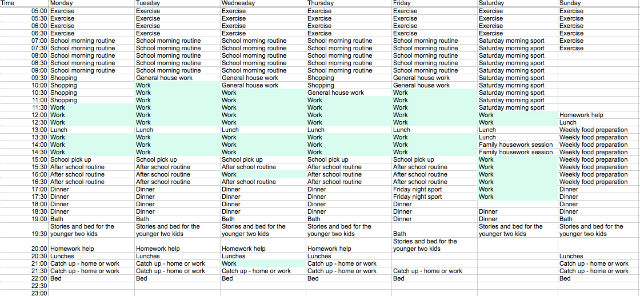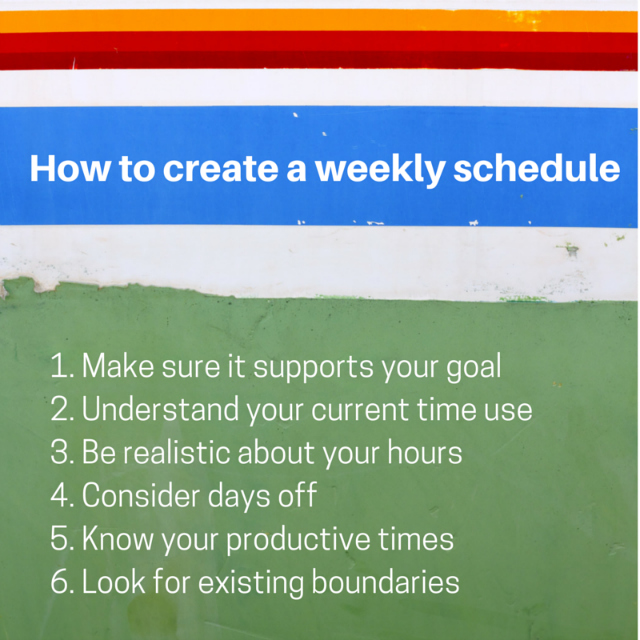A number of times a year I revamp my weekly schedule. Having a weekly schedule is super important to me, so I can make sure I prioritise appropriate activities and they get done.
I am sure if you think about it, you probably have your own weekly schedule stored in your head! My head simply gets to full of things to remember it all, so I create a printable weekly schedule in excel. The weekly schedule incorporates the key activities:
- for me
- for the family
- for work
It DOES NOT include everything that happens in my week. And when there is an activity across a time slot, it may only take 10 minutes and the rest of that time is spent doing what ever I need to do at the time.
By creating a weekly schedule, it allows me to run on auto pilot quite a bit. I have written about decision fatigue before on the blog here, but this is worth repeating as it explains so well why weekly schedules work:
In this post by James Clear he examines a research study published by the National Academy of Sciences, where psychologists examined the factors that impact whether or not a judge approves a criminal for parole and how this relates to everyday decision making:
As it turns out, your willpower is like a muscle. And similar to the muscles in your body, willpower can get fatigued when you use it over and over again. Every time you make a decision, it’s like doing another rep in the gym. And similar to how your muscles get tired at the end of a workout, the strength of your willpower fades as you make more decisions.
Researchers often refer to this phenomenon as decision fatigue. When the judge on a parole board experiences decision fatigue, they deny more parole requests.
Click here to read the full post.
While I am not a judge and I am not denying parole requests (or I possibly could be if it is to do with the teenagers!), if I can eliminate as many decisions as possible from my standard days, it frees up up decision making will power for important business decisions and important parenting decisions.
The weekly schedule tells me what I am going to be doing each day, taking the decision making out of it. Of course there are days, when I abandon the schedule to do what I feel like at that point in time. Plans are great like that. They make it easy to stay on top of things, but they are only plans which can modified, changed and scrapped as needed.
Over the years I have shared what my weekly schedule looks like in these posts:
My weekly schedule currently looks like below. Click on the image to see a larger version:

Things to note about my plan:
- I will repeat – It DOES NOT include everything that happens in my week. And when there is an activity across a time slot, it may only take 10 minutes and the rest of that time is spent doing what ever I need to do at the time.
- General household tasks after school drop offs can often be replaced with chats with school mums.
- The weekends are actually much more fluid than what the schedule appears. Depending on what other sporting and social commitments we have on, the activities may occur on different days/times.
- On a standard weekend where I can, I try to incorporate these activities into my days. Sometimes when I am away for work for example, it doesn’t look anything like that or a weekend full of social occasions, may see it look very different.
- I now try to ensure I have one day a week where I don’t do any work. What day this is will depend on the weekend.
- I am following a new and different for me training (exercise) program at the moment. The hours across the week would be about right, but they may be on different days depending on what my program requires from me.
- I am yet to routinely be in bed by 10.00pm, but I am consistently in bed before 11pm which is a great improvement and a couple of nights a week I am in bed at 10pm or before.
How to create a weekly schedule
I have created work schedules before and found they haven’t worked as well as I would have liked. The main reason for that was I would just take the blank spreadsheet, slot in family stuff and then attempt to allocate work in as many slots as possible.
The reality was however that I didn’t have as much time for work as what I had allocated. But thinking I did, I took on work to fill the time I didn’t have! What this meant was that I ended up working later in the evenings. The result of this would see me tired and not the most patient and present mother the next day – not very useful!
To have a work schedule that will be useful I have worked out there are key things to consider:
1. Make sure it supports your goal/s.
My personal goal for this year is to be a planned, patient and present mother to my 5 beautiful kids. I have much more room to move around my work hours this time around. I am now only taking on work that I know I can achieve in these hours.
I have also made significant changes on how I approach my work, which is giving me more time with the family. This is the topic of post to come!
2. Understand your current time use
When you are scheduling in activities understand how long it takes you to do your key tasks. Shopping for example maybe an hour job door to door, but then it takes another hour to put the groceries away. Make sure you know how long these tasks take and if anything add in some extra time for life’s interruptions.
3. Be realistic about how many hours a week you have
Don’t make the same mistake I made last year and schedule something in every available hour. Look at what happens in your week really. There are school meetings, lunches with friends, family to visit etc. There needs to be room in the schedule for those things that just pop up and happen.
4. Consider days off
This one will not be relevant to everyone, but if like me, you run your own business, it is so easy not to have any days off. I have learnt the hard way that by allowing yourself to have days off, you are actually more productive on the days you do work.
5. Know your productive times
I am a morning person. I schedule my more challenging work tasks in the morning. I find to be productive you need to be working on the right activities at the right time. Work out what are your most productive times and schedule your key activities at those times.
6. Look for existing boundaries
Even if we set times for ourselves, it can be so easy to ignore our own time limits and spend way more time on a task than is needed. Use existing boundaries in your day to help manage any activities that you have a tendency to spend too much time on.
In my schedule for example you will see on Wednesdays after school I have a 30 minutes work session. The kids have their swimming lessons at this time. I use that 30 minutes to write the first draft of my weekly newsletter.
Previously I wrote it in a morning where I had no time pressures and it took me more than double the time to write. As I know I have only 30 minutes, I just stick to it. I work without wifi so I cannot be distracted and I just get it done.
Want to manage your time better, so you can spend more time with the family?
A weekly schedule is just one way that you can manage your time better to allow you to spend more time with your family and other activities you love. I have more in depth explanation of weekly schedules and other time management techniques in my e-course Planned & Present!  Planned & Present is a seven week e-course to take you from feeling our of control and overwhelmed to feeling planned and present. It is a step-by-step guide on how to organise the chaos of family life while still leaving space to enjoy it.
Planned & Present is a seven week e-course to take you from feeling our of control and overwhelmed to feeling planned and present. It is a step-by-step guide on how to organise the chaos of family life while still leaving space to enjoy it.
Through out the course lessons I will take you on a journey where we work out where you are spending your time now, determine where you want to be spending it and creating a plan to get you there. The course will deliver to you:
- Clarity and confidence to deal with competing interests – by determining your “why” you can make navigating this minefield much easier.
- Creation of positive habits – through learning about why habits work and how you can fit them into your life permanently.
- Routines, processes and plans to organise the chaos of family life – there are templates for you to use and routines to follow, so you don’t have to start from scratch.
Planned and Present includes seven in-depth lessons, for you to work through. And with lifetime access to the course, it’s okay if you fall behind.
To find out more about Planned & Present and sign up for the course head here – Planned & Present.

